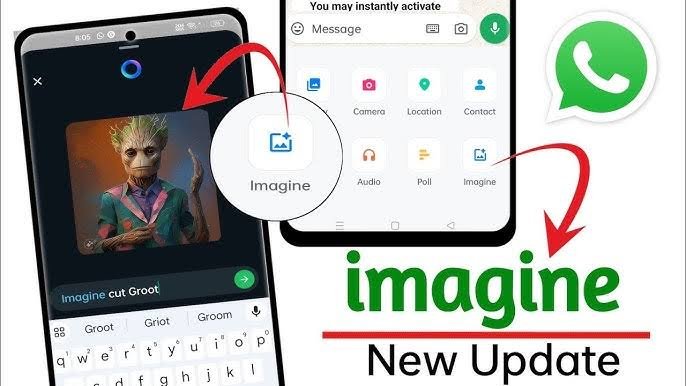WhatsApp’s Imagine Feature: A Glimpse into the Future of AI-Generated Imagery
WhatsApp’s Imagine Feature: A Glimpse into the Future of AI-Generated Imagery
The Rise of AI in Visual Communication
In recent years, artificial intelligence (AI) has revolutionized various industries, and the realm of visual communication is no exception. One groundbreaking development in this space is the integration of AI-powered image generation into popular messaging platforms. WhatsApp, a global messaging giant, has taken a significant step forward with its “Imagine” feature, which allows users to create unique images based on text prompts.
How Does WhatsApp’s Imagine Feature Work?
The Imagine feature leverages advanced AI algorithms to understand and interpret text prompts. When a user types a description, the AI analyzes the words and phrases to generate corresponding visuals. For instance, if a user enters “a cat wearing a hat,” the AI might produce images of felines adorned with various headwear.
Key Features and Capabilities
- Text-to-Image Generation: The core function of Imagine is to convert textual descriptions into visual representations. Users can input a wide range of prompts, from simple concepts to complex scenarios.
- Customization and Iteration: The AI can be fine-tuned to generate images that align closely with the user’s preferences. Users can experiment with different prompts and iterate on the results until they achieve the desired outcome.
- Style and Aesthetic Control: Imagine can be trained on various datasets, allowing users to select specific styles or aesthetics for their images. For example, users can choose between realistic, abstract, or artistic styles.
- Integration with Other Features: WhatsApp’s Imagine feature can be combined with other platform functionalities, such as stickers and GIFs, to enhance visual communication.
Applications and Use Cases
- Creative Expression: Imagine can be a powerful tool for artists, designers, and individuals who enjoy creative pursuits. It can inspire new ideas, generate visual references, and even serve as a starting point for more elaborate projects.
- Education and Learning: Educators can use Imagine to create engaging visual aids for their lessons, making complex concepts more accessible to students. It can also be used to illustrate historical events, scientific phenomena, or fictional worlds.
- Business and Marketing: Businesses can leverage Imagine to create marketing materials, social media content, and product prototypes. It can help streamline the design process and reduce costs.
- Personal Entertainment: Imagine can be a fun way to pass the time and explore one’s imagination. Users can create humorous, surreal, or fantastical images to share with friends and family.
Ethical Considerations and Challenges
While Imagine offers exciting possibilities, it also raises important ethical concerns. One key issue is the potential for AI-generated images to be used to spread misinformation or deepfakes. It is crucial to develop safeguards to prevent the misuse of this technology.
Additionally, there are technical challenges to overcome. The quality and accuracy of AI-generated images can vary depending on the complexity of the prompt and the training data used. As AI continues to advance, researchers are working to improve the capabilities and reliability of these systems.
The Future of AI-Generated Imagery
WhatsApp’s Imagine feature represents a significant milestone in the integration of AI into messaging platforms. As technology evolves, we can expect to see even more sophisticated and versatile AI-powered image generation tools. These tools have the potential to revolutionize the way we communicate, create, and consume visual content.
In conclusion, WhatsApp’s Imagine feature offers a glimpse into the future of AI-generated imagery. By providing users with the ability to create unique visuals based on text prompts, it opens up new avenues for creative expression, education, and business applications. While there are ethical considerations and technical challenges to address, the potential benefits of this technology are immense. As AI continues to advance, we can anticipate even more exciting developments in the field of visual communication.

